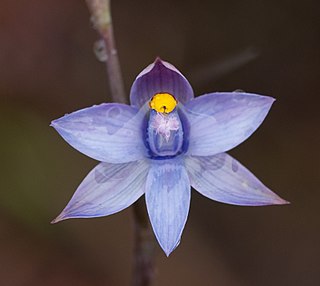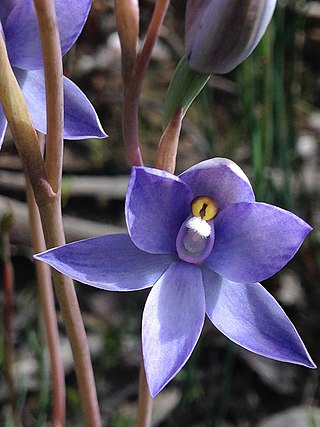Thelymitra frenchii, commonly called the scarp sun orchid or Jarrahdale sun orchid, is a species of orchid in the family Orchidaceae and endemic to a small area in the south-west of Western Australia. It has a single long, fleshy leaf and up to three relatively small, blue flowers.

Thelymitra malvina, commonly called the mauve-tufted sun orchid, is a species of orchid, native to eastern Australia and New Zealand. It has a single large, fleshy leaf and up to twenty-five blue to mauve flowers with pink or mauve tufts on top of the anther.

Thelymitra megacalyptra, known as Thelymitra megcalyptra in Australia, and commonly known as plains sun orchid, is a species of orchid that is endemic to eastern Australia. It has a single erect, fleshy leaf and up to fifteen blue to purplish, sometimes lilac, pink or white flowers with white tufts on top of the anther.

Thelymitra basaltica, commonly called the grassland sun orchid, is a species of orchid that is endemic to Victoria. It has a single fleshy, channelled, dark green leaf and up to eight small pale blue, self-pollinating flowers which open only slowly on warm to hot days.
Thelymitra exigua, commonly called the short sun orchid, is a species of orchid that is endemic to south-eastern Australia. It has a single fleshy, channelled, dark green leaf and up to eight relatively small pale blue flowers with white toothbrush-like tufts on top of the anther.
Thelymitra cyanapicata, commonly called the dark-tipped sun orchid, is a species of orchid that is endemic to South Australia. It has a single fleshy, linear, channelled leaf and up to three small blue or pale purplish to maroon flowers with a dark purplish blue top of the anther.

Thelymitra granitora, commonly called the coastal granite sun orchid or coastal sun orchid, is a species of orchid in the family Orchidaceae and is endemic to the south-west of Western Australia. It has a single short, curved and channelled dark green leaf and up to eight relatively large pale blue or white, self-pollinating flowers with white mop-like tufts on the top of the anther.

Thelymitra holmesii, commonly called the blue star sun orchid, is a species of orchid that is endemic to south-eastern Australia. It has a single long, narrow, fleshy leaf and up to nine purplish blue to mauve flowers with a deeply notched lobe on top of the anther.

Thelymitra peniculata, commonly called the trim sun orchid, is a species of orchid that is endemic to southern eastern Australia. It has a single long, erect, fleshy, channelled leaf and up to eighteen deep blue to purple self-pollinating flowers.
Thelymitra vulgaris, commonly called the slender sun orchid or common sun orchid, is a species of orchid in the family Orchidaceae and endemic to the south-west of Western Australia. It has a single erect, dark green leaf and up to nine relatively small, blue to purplish or white flowers.
Thelymitra xanthotricha, commonly called the yellow tufted sun orchid or yellow tufted slender sun orchid, is a species of orchid in the family Orchidaceae and endemic to the south-west of Western Australia. It has a single erect, fleshy, channelled, dark green leaf and up to six relatively large dark blue to purplish flowers.

Thelymitra mucida, commonly called the plum sun orchid or plum orchid, is a species of orchid that is endemic to southern Australia. It has a single erect, fleshy, linear leaf and up to six blue, purplish or plum coloured flowers with a thick, sticky secretion on the anther lobe.

Thelymitra epipactoides, commonly called the metallic sun orchid, is a species of orchid that is endemic to south-eastern continental Australia. It has a single relatively large, leathery leaf and up to twenty large flowers that range in colour from pink to reddish but have a distinctive arrangement of lobes above the anther.
Thelymitra kangaloonica, commonly known as Kangaloon sun orchid, is a species of orchid that is endemic to a very small area of New South Wales. It has a single erect, relatively narrow, fleshy leaf and up to forty deep blue flowers with darker veins.
Thelymitra jonesii, commonly called the skyblue sun orchid, is a species of orchid that is endemic to Tasmania. It has a single erect, fleshy, linear, dark green leaf and up to six relatively small light blue to azure blue flowers with darker veins. It is a rare orchid known from only four scattered locations in moist coastal heath.
Thelymitra latiloba, commonly called the wandoo sun orchid or wandoo shirt orchid, is a species of orchid in the family Orchidaceae and endemic to the south-west of Western Australia. It has a single erect, fleshy, channelled, dark green leaf and up to twelve blue flowers with darker blue veins and sometimes flushed with mauve. The lobe on top of the anther is wavy.
Thelymitra occidentalis, commonly called the western azure sun orchid or rimmed orchid, is a species of orchid in the family Orchidaceae and is endemic to the south-west of Australia. It has a single erect, fleshy, channelled, dark green leaf and up to fifteen blue flowers with darker blue veins and sometimes flushed with pink. The lobe on top of the anther has a wavy, yellow crest.

Thelymitra dedmaniarum, commonly called the cinnamon sun orchid, is a species of orchid in the family Orchidaceae and is endemic to Western Australia. It has a single flat, leathery leaf and up to fifteen cinnamon scented, golden yellow flowers. It is a rare orchid with a restricted distribution.
Thelymitra stellata, commonly called the star orchid or starry sun orchid, is a species of orchid in the family Orchidaceae and is endemic to the south-west of Western Australia. It has a single erect, flat, leathery leaf and up to twelve brown to reddish brown flowers with yellow streaks and blotches. The column has broad, deeply fringed, orange or yellow wings.
Thelymitra atronitida, commonly called the black-hooded orchid, is a species of orchid that is endemic to south-eastern Australia. It has a single erect, leathery, leaf and up to eight moderately dark blue, self-pollinating flowers that only open on hot days.










